PBS News: Hour full episode December 6 – 9, 2019, and How cuts to food stamp program could increase ‘poor outcomes’ for the food insecure
TED Talks: Eve Ensler- The profound power of an authentic apology? And Hawa Abdi Deqo Mohamed Mother and daughter doctor heroes
The Atlantic: The Battle for the Constitution – Five Common Misconceptions About the Electoral College, and Top 25 News Photos of 2019
Thisiscolossal: Elaborate Chiaroscuro Tattoos by Makkala Rose Burst With Ripe Fruit and Blossoming Flowers
Ing Peace Project: Finished artwork of Malcolm X Shabazz High School’s Students’ comments, poster 2, on “What does Peace mean to you?”
PBS News: Hour full episode December 9, 2019
Dec 9, 2019 PBS NewsHour
Monday on the NewsHour, a long-awaited report on the origins of the FBI’s Russia probe finds errors but no evidence of a political conspiracy against President Trump. Plus: The latest on impeachment, an economic giant passes away, the truth about the war in Afghanistan, friction between Sen. Elizabeth Warren and Pete Buttigieg, Politics Monday and Broadway features the music of Alanis Morissette. WATCH TODAYS SEGMENTS: DOJ report finds Russia probe was appropriately opened https://www.youtube.com/watch?v=-_rW_… Counsels testify in fiery House Judiciary Committee hearing https://www.youtube.com/watch?v=kQhFj… News Wrap: Putin and Zelenskiy have 1st one-on-one meeting https://www.youtube.com/watch?v=Vnkb0… Remembering former Fed chair and economic giant Paul Volcker https://www.youtube.com/watch?v=fTxEC… Report shows how U.S. officials misled public on Afghan war https://www.youtube.com/watch?v=4jPbi… 2020 Democrats compete over transparency as 6th debate nears https://www.youtube.com/watch?v=C_MKk… Tamara Keith and Amy Walter on Warren vs. Buttigieg in Iowa https://www.youtube.com/watch?v=sTd_J… ‘Jagged Little Pill’ becomes a musical — and a metaphor https://www.youtube.com/watch?v=m809y… Stream your PBS favorites with the PBS app: https://to.pbs.org/2Jb8twG Find more from PBS NewsHour at https://www.pbs.org/newshour Subscribe to our YouTube channel: https://bit.ly/2HfsCD6
PBS NewsHour Weekend full episode December 8, 2019
Dec 8, 2019 PBS NewsHour
On this edition for Sunday, December 8, the U.S. Navy releases names of the three sailors killed in the Pensacola rampage, House Democrats to present their case for impeaching President Trump, and Ukraine and Russia prepare for peace talks after nearly six years of conflict. Hari Sreenivasan anchors from New York. Stream your PBS favorites with the PBS app: https://to.pbs.org/2Jb8twG Find more from PBS NewsHour at https://www.pbs.org/newshour Subscribe to our YouTube channel: https://bit.ly/2HfsCD6
PBS NewsHour Weekend full episode December 7, 2019
Dec 7, 2019 PBS NewsHour
On this edition for Saturday, December 7, a U.S. official says a Saudi officer watched mass shooting videos before his deadly rampage at Pensacola’s naval base, and Scotland eyes an opportunity for independence as Great Britain gets ready to head to the polls. Hari Sreenivasan anchors from New York. Stream your PBS favorites with the PBS app: https://to.pbs.org/2Jb8twG Find more from PBS NewsHour at https://www.pbs.org/newshour Subscribe to our YouTube channel: https://bit.ly/2HfsCD6
PBS NewsHour full episode December 6, 2019
Dec 6, 2019
Friday on the NewsHour, much of France is at a standstill amid mass protests of President Emmanuel Macron’s proposed pension reforms. Plus: The truth behind the conspiracy theory of Ukrainian interference in the 2016 U.S. presidential election, analysis of political news with Mark Shields and David Brooks, a Van Gogh exhibition and the challenge of getting farmers the medical care they require. WATCH TODAYS SEGMENTS: News Wrap: Gunman kills 3 at Naval Air Station Pensacola https://www.youtube.com/watch?v=0088C… How French pension protests could threaten Macron’s agenda https://www.youtube.com/watch?v=I4MOx… The facts behind Trump’s claims about Ukraine https://www.youtube.com/watch?v=MCN8t… Shields and Brooks on impeachment evidence, Pelosi’s power https://www.youtube.com/watch?v=3XMD7… New show presents Van Gogh next to artists who inspired him https://www.youtube.com/watch?v=QKqij… How a community of care can improve farmworkers’ health https://www.youtube.com/watch?v=geSw1… Stream your PBS favorites with the PBS app: https://to.pbs.org/2Jb8twG Find more from PBS NewsHour at https://www.pbs.org/newshour Subscribe to our YouTube channel: https://bit.ly/2HfsCD6 Follow us: Facebook: https://www.pbs.org/newshour Twitter: https://www.twitter.com/newshour Instagram: https://www.instagram.com/newshour Snapchat: @pbsnews Subscribe: PBS NewsHour podcasts: https://www.pbs.org/newshour/podcasts Newsletters: https://www.pbs.org/newshour/subscribe
Category News & Politics
How cuts to food stamp program could increase ‘poor outcomes’ for the food insecure
Dec 4, 2019 PBS NewsHour
The Trump administration is making some major changes to the food stamp program, known as SNAP. On Wednesday, the U.S. Department of Agriculture finalized a new rule expected to end access to the benefit for nearly 700,000 people by enforcing tougher work standards and limiting exemptions. The Urban Institute’s Elaine Waxman joins Amna Nawaz to discuss. Stream your PBS favorites with the PBS app: https://to.pbs.org/2Jb8twG Find more from PBS NewsHour at https://www.pbs.org/newshour Subscribe to our YouTube channel: https://bit.ly/2HfsCD6 Follow us: Facebook: https://www.pbs.org/newshour Twitter: https://www.twitter.com/newshour Instagram: https://www.instagram.com/newshour Snapchat: @pbsnews Subscribe: PBS NewsHour podcasts: https://www.pbs.org/newshour/podcasts Newsletters: https://www.pbs.org/newshour/subscribe
Category News & Politics
Genuine apology goes beyond remorse, says legendary playwright Eve Ensler. In this frank, wrenching talk, she shares how she transformed her own experience of abuse into wisdom on what wrongdoers can do and say to truly repent — and offers a four-step roadmap to help begin the process. (This talk contains mature content.)
This talk was presented at an official TED conference, and was featured by our editors on the home page.
About the speaker
Eve Ensler · Playwright, activist
They’ve been called the “saints of Somalia.” Doctor Hawa Abdi and her daughter Deqo Mohamed discuss their medical clinic in Somalia, where — in the face of civil war and open oppression of women — they’ve built a hospital, a school and a community of peace.
This talk was presented at an official TED conference, and was featured by our editors on the home page.
About the speaker
Dr. Hawa Abdi + Dr. Deqo Mohamed · Somali doctors who treat women refugees
Pocket Worthy Stories to fuel your mind.
The World Will Finally Have to Confront Its Massive Plastic Problem Now That China Won’t Handle It
Now that China won’t take it, the world will have an extra 111 million metric tons of its plastic waste to deal with by 2030.
Quartz Zoë Schlanger
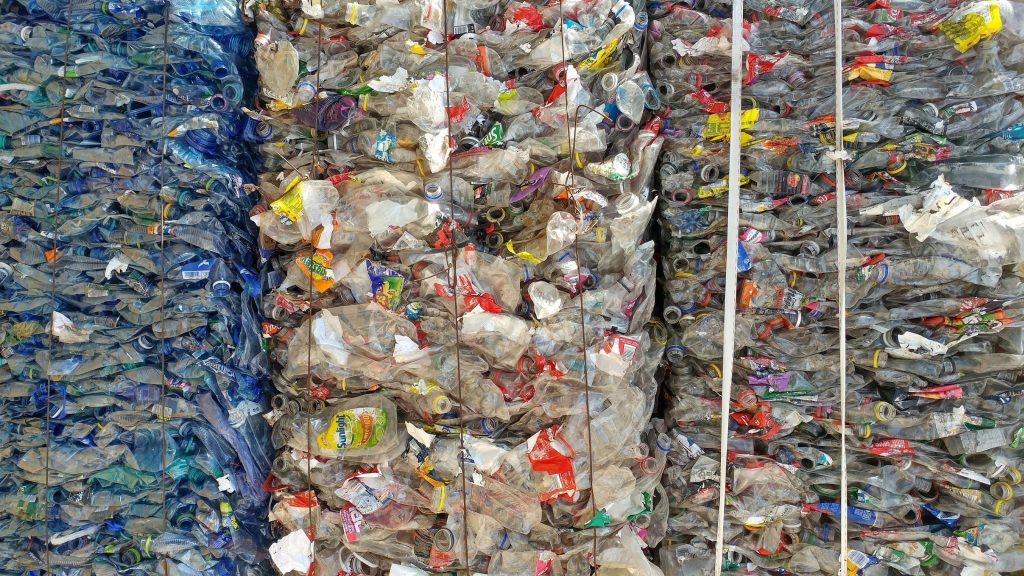
Photo by Jenna Jambeck, University of Georgia.
Since the 1950s, when the world was first introduced to the flexible, durable wonder of plastic, 8.3 billion metric tons of it has been produced. Plastic doesn’t biodegrade, so technically, all of that tonnage is still sitting someplace on the planet. And a lot of it is in China.
That’s because when hundreds of countries around the world said they were “recycling” their plastic over the past few decades, half the time what they really meant was they were exporting it to another country. And most of the time, that meant they were exporting it to China. Since 1992, China (and Hong Kong, which acts as an entry port into mainland China) have imported 72 percent of all plastic waste.
But China has had enough. In 2017, China announced it was permanently banning the import of nonindustrial plastic waste. According to a paper published in June 2018 in the journal Science Advances, that will leave the world—mostly high-income countries—with an additional 111 million metric tons of plastic to deal with by 2030. And right now, those countries have no good way to handle it.
As of 2016, the top five countries exporting their plastic to China were the US, the UK, Mexico, Japan, and Germany.
For example, that year, the US exported 56 percent of its plastic waste to China, with another 32 percent going to Hong Kong (of which most is then exported to China). The US exported its remaining 12 percent to Mexico, Canada, and India. Germany, meanwhile, exports 69 percent of its plastic to China.
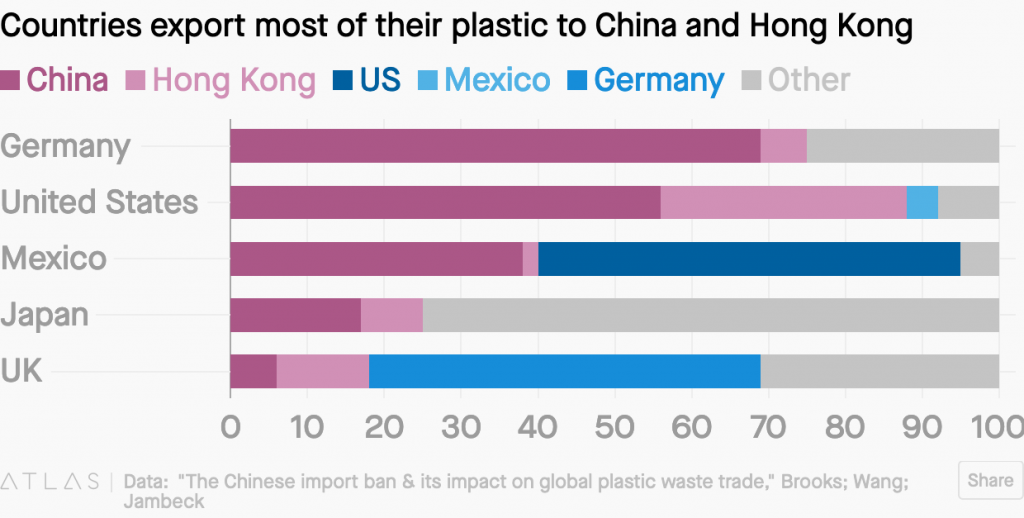
But because flows of plastic are convoluted, it’s possible these numbers don’t tell the whole story. For example, the researchers note that the UK exports 51 percent of its plastic to Germany, but given how much plastic Germany exports to China, it’s seems plausible that much of the UK’s plastic ultimately ends up in China. The same goes for Mexico, which exports 55 percent of its plastic to the US. The US, in turn, exports most of its plastic to China. But the researchers write the United Nations trade data on which they based their research does not monitor flows of plastic between countries, so “we do not know whether that waste is then processed domestically or exported to Hong Kong or China,” they write.
China has in the past tried to limit plastic imports. In 2013, the country implemented a “Green Fence” policy of restricting the types of plastic waste it would accept, with the goal of reducing contamination. The policy lasted only a year, but it was enough to rattle the waste industry. “As a result, plastic recycling industries experienced a globally cascading effect since little infrastructure exists elsewhere to manage the rejected waste,” the researchers write.
That’s already happening again, and now the ban is permanent.
The rule went into effect on January 1, 2018, and plastic immediately began piling up in several European countries, the port of Hong Kong, and the US. “My inventory is out of control,” Steve Frank, who owns recycling plants in Oregon, which up until then had exported most of its materials to China, told the New York Times at the time. He hoped he’d be able to start exporting more waste to countries like Indonesia, India, Vietnam, Malaysia—“anywhere we can”—but “they can’t make up the difference,” he said.
At the end of the day, even the 111 million metric tons of plastic that the researchers found would be back in the laps of countries who used to export to China is still a fraction of all the plastic that gets produced.
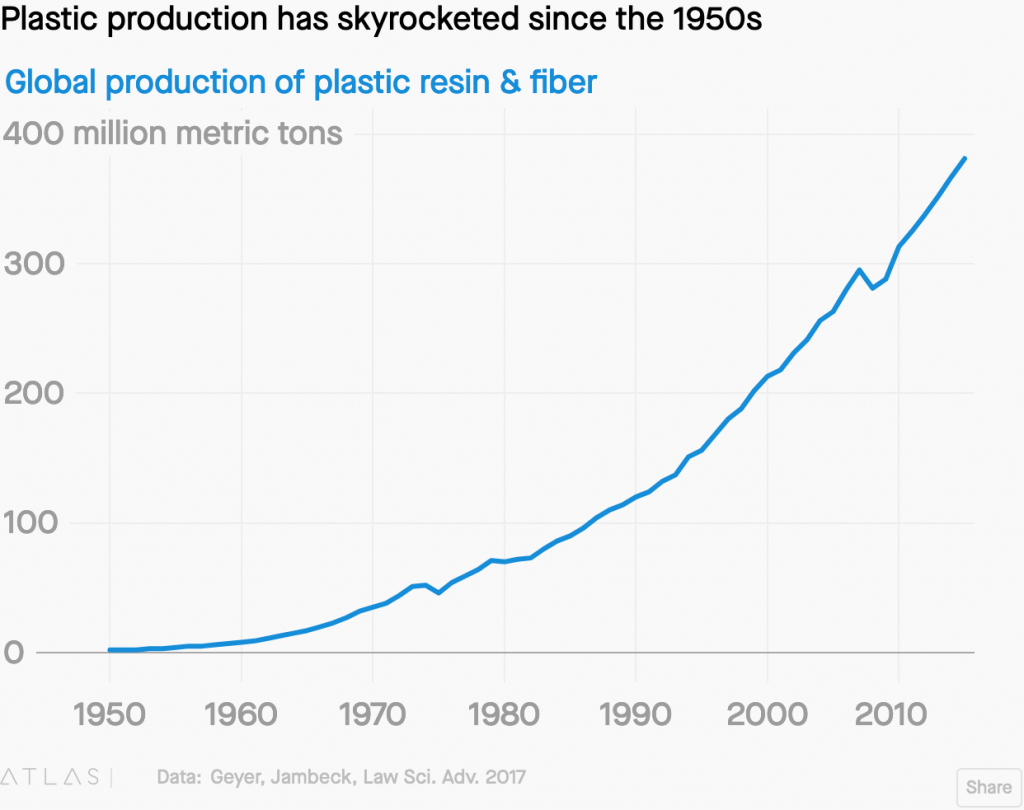
“We know from our previous studies that only 9 percent of all plastic ever produced has been recycled, and the majority of it ends up in landfills or the natural environment,” Jenna Jambeck, an associate professor at the University of Georgia’s college of engineering who co-authored the study, said in a statement. ”Without bold new ideas and system-wide changes, even the relatively low current recycling rates will no longer be met, and our previously recycled materials could now end up in landfills.”
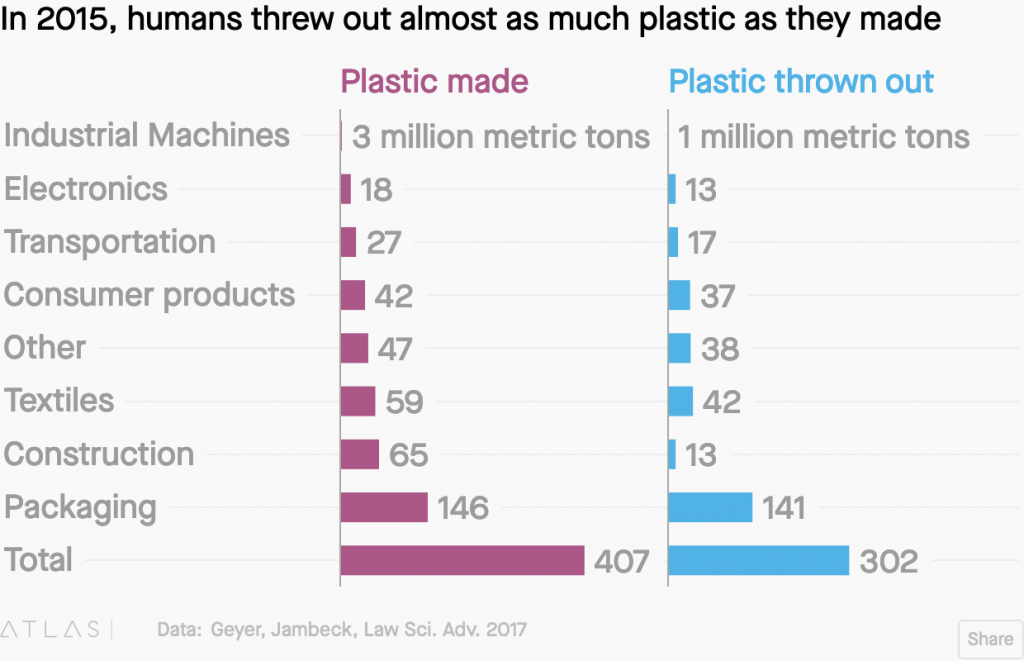
For more information please visit the following link:
The Battle for the Constitution
Five Common Misconceptions About the Electoral College
Defenders of the Electoral College argue that it was created to combat majority tyranny and support federalism, and that it continues to serve those purposes. This stance depends on a profound misunderstanding of the history of the institution.
history of the institution.
November 29, 2019
Board of Governors Professor at Rutgers University-Camden
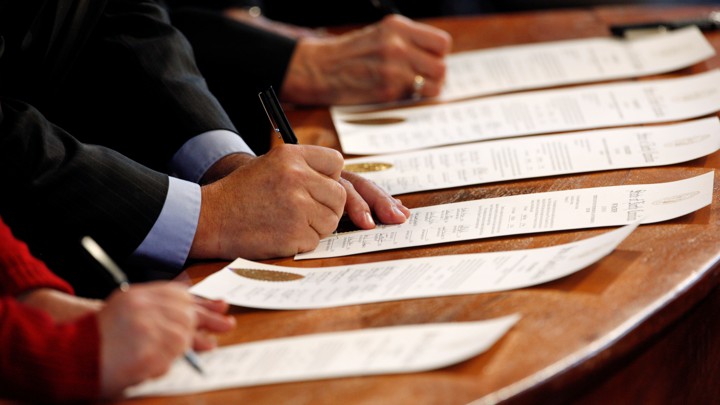
North Carolina Electoral College representatives sign the Certificates of Vote after they all cast their ballots for U.S. President-elect Donald Trump in the State Capitol building in Raleigh, North Carolina, U.S., December 19, 2016.Jonathan Drake / Reuters
Two of the nation’s last three presidents won the presidency in the Electoral College, even though they lost the popular vote nationwide. In 2000, Al Gore outpolled George W. Bush by more than 540,000 votes but lost in the Electoral College, 271–266. Sixteen years later, Hillary Clinton tallied almost 3 million more votes than Donald Trump but lost decisively in the Electoral College, 306–232. And, as a recent New York Times poll suggested, the 2020 election could very well again deliver the presidency to the loser of the popular vote.
Despite this, defenders of the Electoral College argue that it was created to combat majority tyranny and support federalism, and that it continues to serve those purposes. For example, Representative Dan Crenshaw of Texas, responding to Representative Alexandria Ocasio-Cortez’s recent criticism of the Electoral College, tweeted that “we live in a republic, which means 51% of the population doesn’t get to boss around the other 49%,” and that the Electoral College “promotes more equal regional representation and protects the interests of sparsely populated states.”
But arguments like these are flawed, misunderstanding the pertinent history. Below, I identify five common mistakes made in arguing for the preservation of the Electoral College.
More in this series
How to Revive Madison’s Constitution
Michael Gerhardt Jeffrey Rosen
The Obscure—But Crucial—Rules the Trump Administration Has Sought to Corrupt
I Know What It’s Like to Carry Out Executions
Mistake Number 1: Many supporters of the Electoral College assume that the debate about presidential selection at the Constitutional Convention, like the debate today, focused on whether the president should be chosen by the Electoral College or by a nationwide popular vote.
But as tempting as it is to read history in the light of contemporary concerns, the debate at the convention focused on a different issue: Should Congress choose the president? Both the Virginia Plan and the New Jersey Plan, the two primary alternatives at the Convention, proposed that Congress select the president. This was unsurprising because in most states at the time, the legislature chose the governor. On June 1, the convention voted 8–2 that Congress should elect the president, and the delegates would affirm that decision on three other occasions.
The frequency with which the delegates revisited the issue reveals not their confidence but their dissatisfaction. Most delegates wanted the executive to check legislative usurpations and block unjust or unwise laws, but they feared that dependence on the legislature for election—and possible reelection—would compromise the executive’s independence. Some delegates hoped to avoid this danger by limiting the president to a single term, but as Gouverneur Morris of Pennsylvania observed, this could deprive the nation of a highly qualified executive, eliminate the hope of continuation in office as a spur to good behavior, and encourage the executive to “make hay while the sun shines.” James Madison added that election by the legislature would “agitate and divide the legislature so much that the public interest would materially suffer” and might invite the intervention of foreign powers seeking to influence the choice.
The difficulty lay in finding an alternative to legislative selection, and the delegates considered and rejected various possibilities, including popular election. Ultimately, perhaps in desperation, they referred the issue to the Committee on Unfinished Parts. On September 4, less than two weeks before the convention ended, the committee proposed the Electoral College. Its proposal mirrored the states’ distribution of power in Congress; each state had as many electoral votes as it had members of Congress. But because the electors dispersed after voting for the president, the Electoral College did not threaten the independence of the executive. With only minor adjustments—most notably, the House replaced the Senate as the body that would select the president if a majority of electors failed to agree on a candidate—the convention endorsed the proposal.
The point of all this is, the Electoral College did not emerge because of opposition to popular election of the president.
Wilfred Codrington III: The Electoral College’s racist origins
Mistake Number 2: Another common belief is that the convention rejected popular election of the president because the delegates feared majority tyranny. People make this claim as though to say that because the Framers were skittish of a national popular election, so should we be today.
But, once again, this interpretation of history is wrong. The convention did twice reject popular election of the president. But the delegates who rejected it did not object to popular elections per se—they had no problem with popular election of the House of Representatives or state legislatures. Rather, they were skeptical of a national popular election, primarily for reasons that are no longer relevant today.
First, they feared that people would lack the information to make an informed choice as to who might be an appropriate candidate for the presidency or who might be the best choice among candidates. Thus George Mason of Virginia claimed, “It would be as unnatural to refer the choice of a proper candidate for chief Magistrate to the people, as it would be to refer a trial of colours to a blind man.”
But his reason was that “the extent of the Country renders it impossible that the people can have the requisite capacity to judge of the respective pretensions of the Candidates.” In such circumstances, he thought, voters would naturally gravitate to candidates from their own state. Delegates who favored popular election replied that “the increasing intercourse among the people of the states would render important characters less and less unknown,” and that “continental characters will multiply as we more or more coalesce,” reducing state parochialism. Today, with mass communication and interminable campaigns, lack of information is no longer a problem.
Second, some southern delegates feared that popular election of the president would disadvantage their states. James Madison noted that, given less restrictive voting laws, “the right of suffrage was much more diffusive in the Northern than the Southern states,” which would give them an advantage in a popular election. Beyond that, a popular vote would not count the disenfranchised enslaved population, reducing southern influence.
The Electoral College solved both those problems, awarding electoral votes based on a state’s population, not its electorate, and importing the three-fifths compromise into presidential elections. The effects were immediate and dramatic—in 1800 John Adams would have defeated Thomas Jefferson had only free persons been counted in awarding electoral votes. Obviously, these concerns no longer apply, although popular election would encourage states to increase their influence by expanding their electorate, while the Electoral College offers no such incentive.
Read: The Electoral College was meant to stop men like Trump from being president
Third, some small-state delegates opposed popular election because they feared that larger states, with their greater voting power, would dominate. Yet these same delegates also objected to the Electoral College, insisting it too gave excessive power to the large states. Their concerns were addressed by stipulating that should no candidate receive a majority of the electoral vote, the selection would devolve on the House of Representatives, with each state casting a single vote.
What is striking about the convention’s debate on popular election of the president is that its opponents did not claim it would encourage majority tyranny. Doubtless the delegates were aware of the danger of such a tyranny—Madison first presented his famous discussion of “majority faction” at the convention—but no delegate objected to popular election on that basis, and Madison himself supported popular election of the president.
Mistake Number 3: Similarly, some defenders of the Electoral College have argued that the delegates who favored the Electoral College opposed popular election of the president.
Given the current debate on presidential selection, this might seem obvious, but the deliberations at the convention were much more fluid. James Wilson of Pennsylvania first proposed popular election of the president, but when his motion failed, he immediately raised the possibility of a mediated popular election: electors chosen by the people who would select the executive. All the other leading advocates of popular election—Morris, Madison, and Alexander Hamilton—also supported the Electoral College, primarily as an alternative to congressional selection. In defending the Electoral College, Madison and Hamilton emphasized its popular character. Madison in “Federalist No. 39” noted that “the President is indirectly derived from the choice of the people,” and Hamilton in “Federalist No. 68” concurred: “The sense of the people should operate in the choice of the person to whom so important a trust was to be confided,” and reelection should depend on “the people themselves.”
Mistake Number 4: Many people also believe that the Electoral College was designed to preserve federalism and states’ rights.
The Constitution was, in James Madison’s words, “in strictness neither a national nor a federal Constitution, but a composition of both.” It empowered state legislatures to determine how the presidential electors were to be chosen, and if the Electoral College failed to select a president, the House of Representatives would, with each state casting a single vote. However, the debates during the Constitutional Convention make clear that the Electoral College was not intended to protect the states or enhance the influence of state governments and state perspectives.
The convention delegates sought to safeguard the independence of the national executive from state governments. They overwhelmingly rejected proposals that the executive be selected by state legislatures or by state governors. They also rejected a proposal that the president be removable upon request by a majority of state legislatures and did not even consider the New Jersey Plan’s provision that the president “be recalled by Congress when requested by the majority of executive of the states.” This was hardly surprising. Most delegates were sharply critical of state legislatures and wanted to ensure that the president had the independence necessary to oppose their schemes. Madison summarized the prevailing sentiment: “The President is to act for the people, not the States.”
Although the Electoral College allowed state legislatures to determine how electors would be chosen, it was expected that once selected, the electors would operate independently of their state governments. The constitutional ban on senators serving as electors and the choice of the House to resolve deadlocks in the Electoral College ensured that those selected by (and perhaps influenced by) state legislatures would not play a role in selecting the president. Beyond that, the delegates expected that the electors’ deliberations would remain secret, that they would be free to choose the candidates they believed most qualified, and that their votes would be tabulated and transmitted to the president of the Senate without any indication as to who voted for which candidate, so that no political retribution could be exacted. The Constitution’s requirement that electors vote for two candidates, at least one of whom was not from their state, served to reduce state parochialism and encourage a national perspective.
In sum, the Electoral College was not designed to promote federalism—Martin Diamond, one of the most thoughtful proponents of the Electoral College, accurately described the design as “an anti-states-rights device, a way of keeping the election from state politicians and giving it to the people.” The core protections of federalism, today as in the past, are the vitality of state governments, the division of powers between nation and state, and representation in Congress along state lines. The replacement of the Electoral College by a nationwide popular vote would threaten none of these. Voting procedures would remain the same, the only difference being that votes would be tabulated nationwide rather than state by state.
Read: The Electoral College wasn’t meant to overturn elections
Mistake Number 5: And finally, perhaps the most widely believed and, at the same time, most incorrect of the arguments for the Electoral College is that it has vindicated the hopes and expectations of its creators.
To begin with, to some extent those expectations were unclear. For example, after the Electoral College was proposed, some delegates claimed that in most elections—George Mason predicted “nineteen times in twenty”—no candidate would get a majority of the electoral votes, and so the House of Representatives would elect the president. This of course would compromise the independence of the executive, and both Madison and Hamilton unsuccessfully proposed that the House’s role be eliminated, with the candidate winning a plurality of the electoral vote becoming president. Other delegates expected that a majority of the electors would coalesce around a single candidate. In “Federalist No. 39,” Madison presumed that “the eventual election” would be made by the House, but this was mere speculation and quickly disproved.
Even when the delegates’ hopes and expectations were clear, constitutional amendments have altered the operation of the Electoral College. The Twelfth Amendment, adopted after the contested election of 1800, requires electors to specify for whom they are voting for president and vice president. The Twentieth Amendment, by shifting the date congressional terms begin to January 3, ensures that the newly elected House of Representatives, rather than the previous House, would elect the president if no candidate received an electoral-vote majority. And the Twenty-Third Amendment extends the right to vote in presidential elections to U.S. citizens residing in the District of Columbia, awarding the District three electoral votes, though the Electoral College continues to deny American citizens living in Puerto Rico and other U.S. territories any role in choosing the president.
Even more important have been changes in political practice. In “Federalist No. 64,” John Jay maintained that the Electoral College “will in general be composed of the most enlightened and respectable citizens,” and in “Federalist No. 68,” Alexander Hamilton described the electors as “most likely to possess the information and discernment” necessary to choose the chief executive. But by 1800 political parties had developed, and elector discretion was replaced by elector commitment to the parties’ candidates. Today many states do not even bother to list the electors’ names on the ballot. Interestingly, Hamilton and Madison as party leaders played a crucial role in this transformation.
Read: The Electoral College conundrum
The Constitution authorized state legislatures to determine how electors were to be selected, but by 1828 every state but South Carolina chose its electors by popular vote, and today all states do. Moreover, despite the initial expectation that electors would be chosen in districts, by 1836 party competition had promoted a winner-take-all allocation of electors in all the states. (Maine and Nebraska have since bucked that trend.) This in turn has affected presidential campaigns, as more and more candidates target their speeches, campaign appearances, and ads at “swing states” and largely ignore states they confidently expect to carry or to lose.
Meanwhile, the proliferation of primary elections, the nationalization of the choice of presidential candidates, the move toward candidate-based campaigns, and the reduced importance of state party organizations have fundamentally transformed presidential selection, without changing how votes are awarded under the Electoral College.
In “Federalist No. 68,” Alexander Hamilton contended that the Electoral College would frustrate “the desire in foreign powers to gain an improper ascendant in our councils.” It would also “afford a moral certainty that the office of President [would] seldom fall to the lot of any man who is not in an eminent degree endowed with the requisite qualifications.” In addition, it would keep from the office candidates with “talents for low intrigue, and the little arts of popularity.” In evaluating the Electoral College today, one must judge whether Hamilton’s hopes have been vindicated.
This story is part of the project “The Battle for the Constitution,” in partnership with the National Constitution Center.
We want to hear what you think about this article. Submit a letter to the editor or write to letters@theatlantic.com.
G. Alan Tarr is professor emeritus at Rutgers University-Camden. He is the author of Without Fear or Favor and Understanding State Constitutions.
For more information please visit the following link:
https://www.theatlantic.com/photo/2019/12/top-25-news-photos-2019/602848/
Alan Taylor December 2, 2019
25 Photos In Focus
As we approach the end of a year of unrest, here is a look back at some of the major news events and moments of 2019. Massive protests were staged against existing governments in Hong Kong, Chile, Iraq, Iran, Venezuela, Haiti, Algeria, Sudan, and Bolivia, while climate-change demonstrations and strikes took place worldwide. An impeachment inquiry into President Donald Trump was started, conflict in Syria continued, the United States won the Women’s World Cup, Hurricane Dorian lashed the Bahamas, and so much more. Here, we present the Top 25 news photos of 2019. Be sure to also see these more comprehensive stories—2019: The Year in Photos, Part 1, Part 2, and Part 3.
Hints: View this page full screen. Skip to the next and previous photo by typing j/k or ?/?.

Jacinda Ardern, prime minister of New Zealand, hugs a mosque-goer at the Kilbirnie mosque in Wellington, on March 17, 2019. Earlier that day, 51 people were killed and another 49 were injured in shooting attacks on two mosques in Christchurch—the worst mass shooting and terror attack in New Zealand’s history. #
Hagen Hopkins / Getty
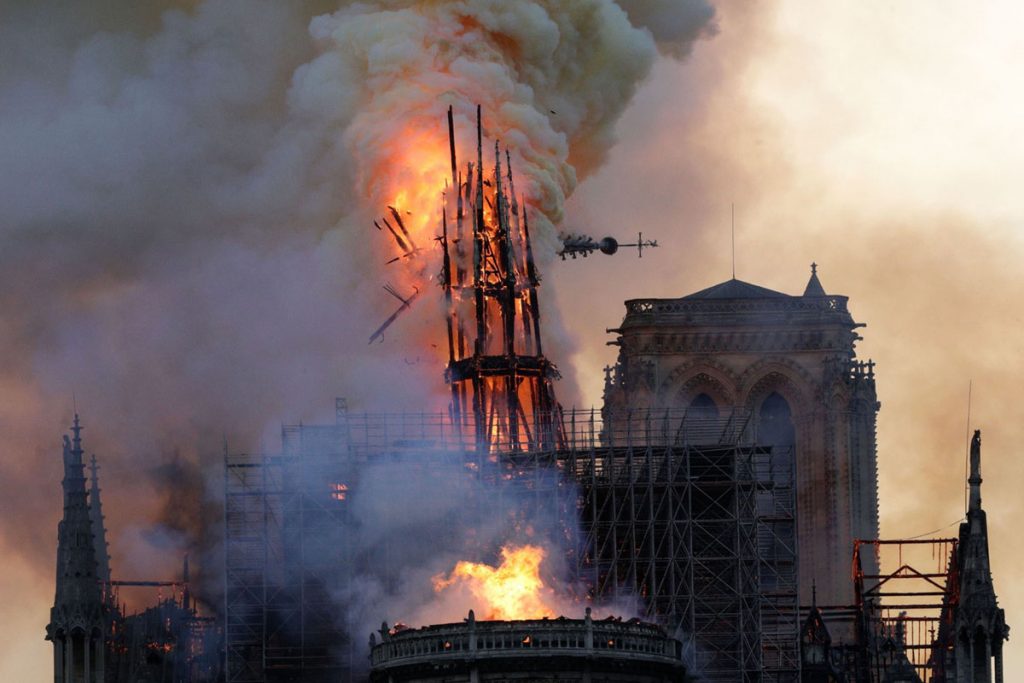
The spire of Notre-Dame collapses as the cathedral is engulfed in flames in central Paris on April 15, 2019. Much of the roof collapsed in the fire, which ignited during renovations. President Emmanuel Macron immediately indicated that the cathedral would be rebuilt, but the method and form of the reconstruction became a political battle, with one side favoring modern redesigns, and the other advocating for an exact replica of the previous structure. #
Geoffroy Van Der Hasselt / AFP / Getty

Spike Lee, winner of the Best Adapted Screenplay award for BlacKkKlansman, attends the 91st annual Academy Awards Governors Ball at the Hollywood & Highland Center in Hollywood, California, on February 24, 2019. Although Lee had been awarded an honorary Oscar in 2015, this was his first competitive Academy Award. #
Robyn Beck / AFP / Getty
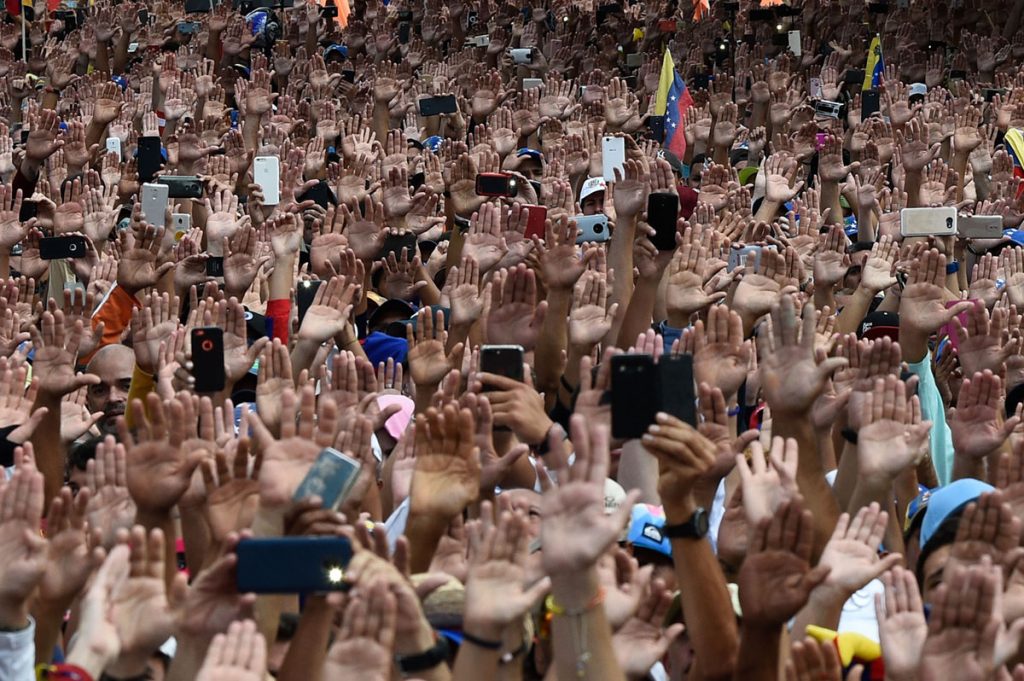
People raise their hands during a mass opposition rally against President Nicolás Maduro, in which Venezuela’s National Assembly head, Juan Guaidó, declared himself the country’s “acting president” on the anniversary of a 1958 uprising that overthrew a military dictatorship, in Caracas, Venezuela, on January 23, 2019. The movement, sparked by disputed election results, led to a presidential crisis in Venezuela that continued throughout the year. #
Federico Parra / AFP / Getty

President Donald Trump turns to House Speaker Nancy Pelosi of California as he delivers his State of the Union address to a Joint Session of Congress on Capitol Hill in Washington, D.C., as Vice President Mike Pence watches, on February 5, 2019. #
Doug Mills / The New York Times via AP
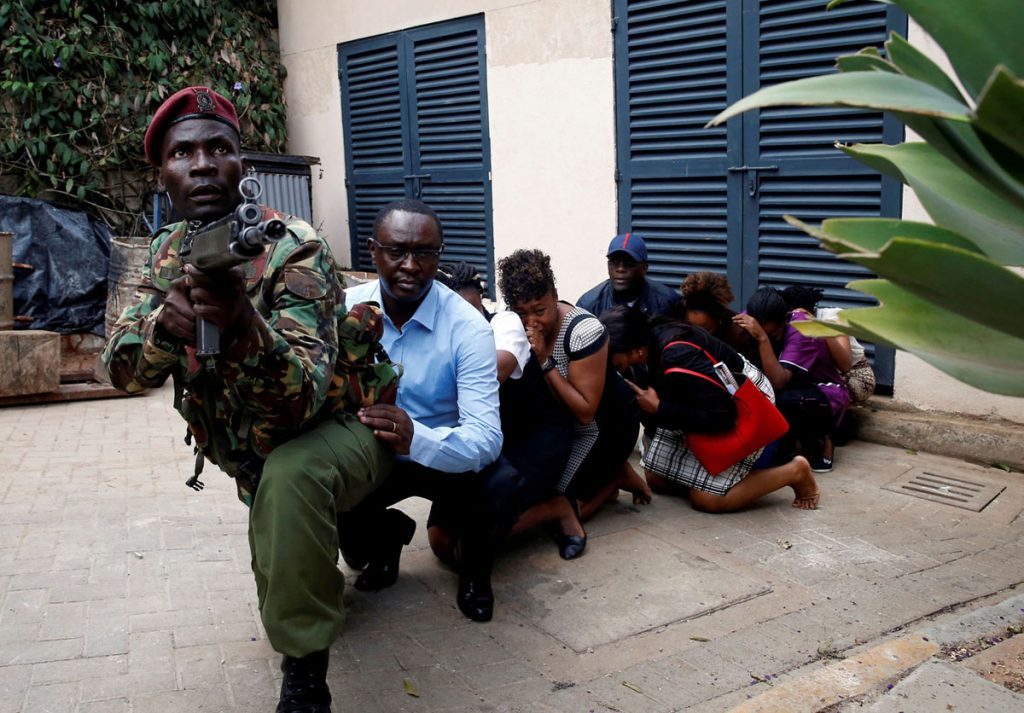
People are evacuated by a member of security forces at the scene of a terror attack at the Dusit Hotel compound in Nairobi, Kenya, on January 15, 2019. The attack, carried out by members of the jihadist militant group Al-Shabaab, left 21 civilians dead. #
Baz Ratner / Reuters

A wounded Syrian girl awaits rescue from under the rubble next to the body of her sister (hands visible at right), who did not survive a regime bombardment in Khan Sheikhun in the southern countryside of the rebel-held Idlib province, on February 26, 2019. Five months after this photo, the Syrian photographer who took it, Anas Al-Dyab, was killed in an air strike in Khan Sheikhun. Al-Dyab was also a member of the “White Helmets,” a group of volunteers carrying out search-and-rescue efforts in Syria. #
Anas Al-Dyab / AFP / Getty
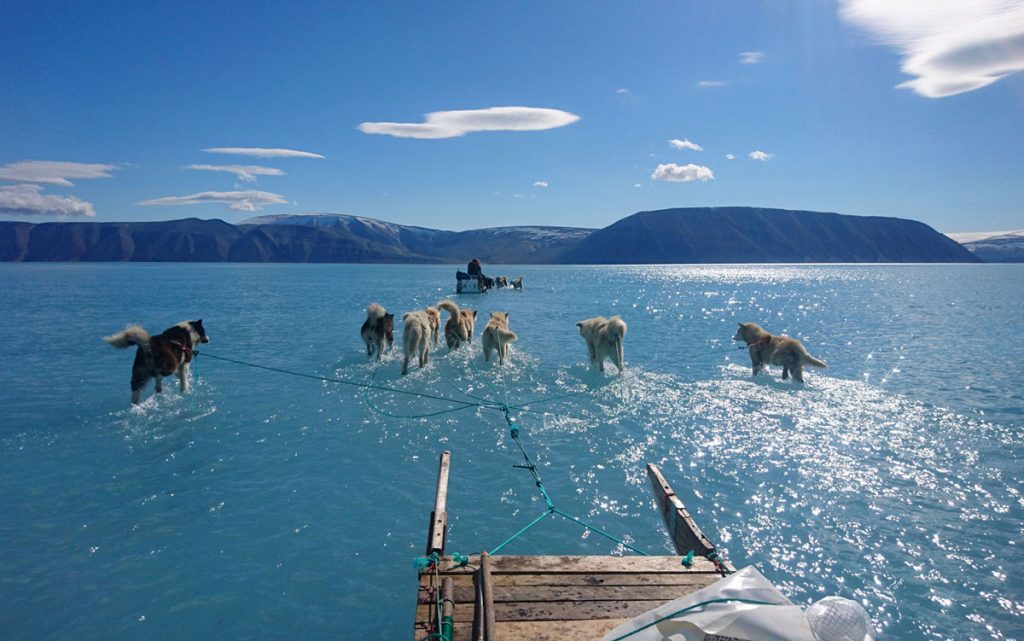
Dogs pull a sled on water-covered sea ice near Qaanaaq, Greenland, on June 13, 2019. The dogs were forced to wade after an abundance of water from a rapid summer melt had pooled on top of a wide swath of solid sea ice. #
Steffen Olsen / Danish Meteorological Institute via Reuters

A boy walks out of the sea while removing oil spilled on Itapuama beach, located in the city of Cabo de Santo Agostinho in Pernambuco state, Brazil, on October 21, 2019. Large blobs of oil staining more than 130 beaches in northeastern Brazil began appearing in early September and have now turned up along a 2,000-kilometer stretch of the Atlantic coastline. The source of the patches remains a mystery despite President Jair Bolsonaro’s assertions they came from outside the country and were possibly the work of criminals. #
Leo Malafaia / AFP / Getty
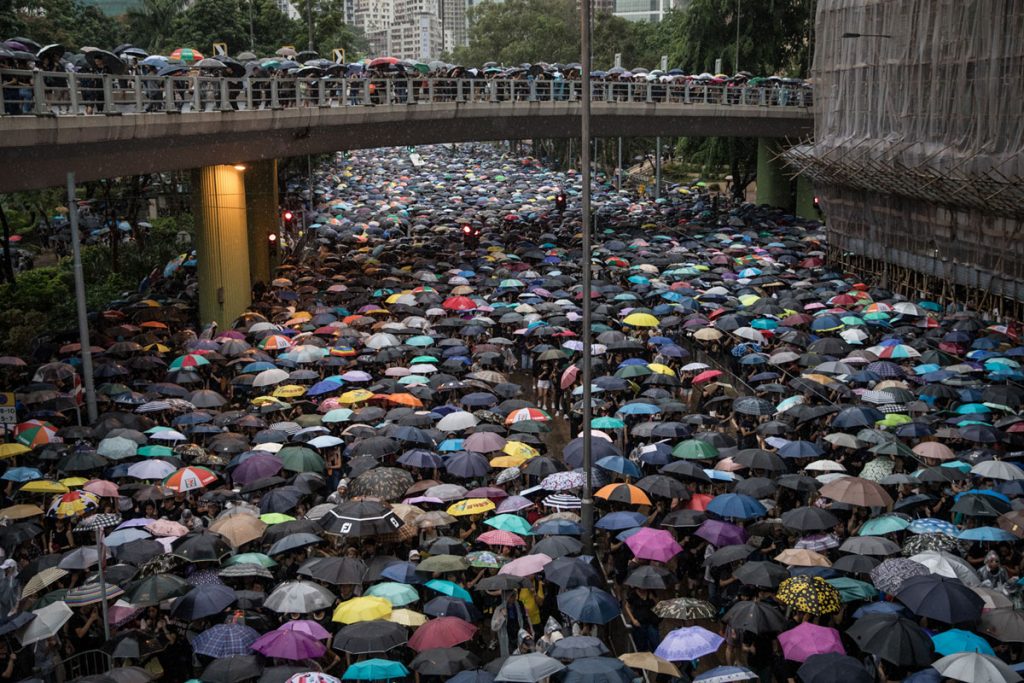
Thousands of pro-democracy protesters march on a street after leaving a rally in Victoria Park on August 18, 2019, in Hong Kong. Demonstrations have taken place on the streets of Hong Kong since June 9, beginning as a reaction to a controversial extradition bill, and evolving into broader demands for democracy and investigations into police brutality, challenging Beijing’s authority. #
Chris McGrath / Getty
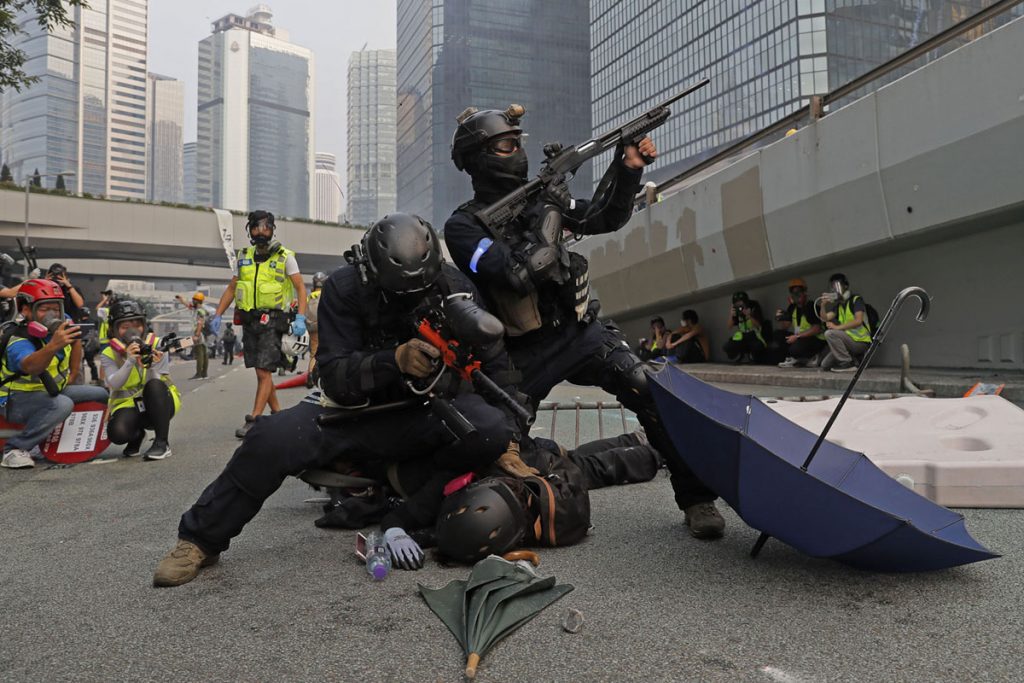
Police detain pro-democracy demonstrators during a demonstration in Hong Kong on September 29, 2019. #
Kin Cheung / AP
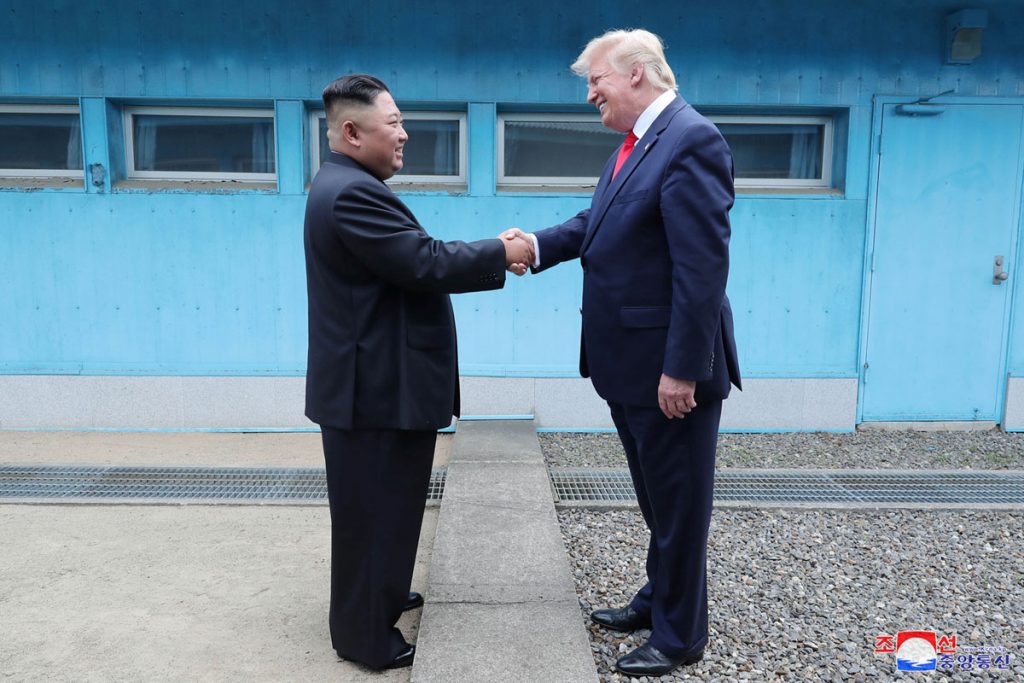
U.S. President Donald Trump shakes hands with North Korean leader Kim Jong Un as they meet at the demilitarized zone separating the two Koreas, in Panmunjom, South Korea, on June 30, 2019, in this image provided by North Korea’s Korean Central News Agency (KCNA). During the meeting, Trump became the first sitting U.S. president to cross the border and enter North Korea. #
KCNA via Reuters
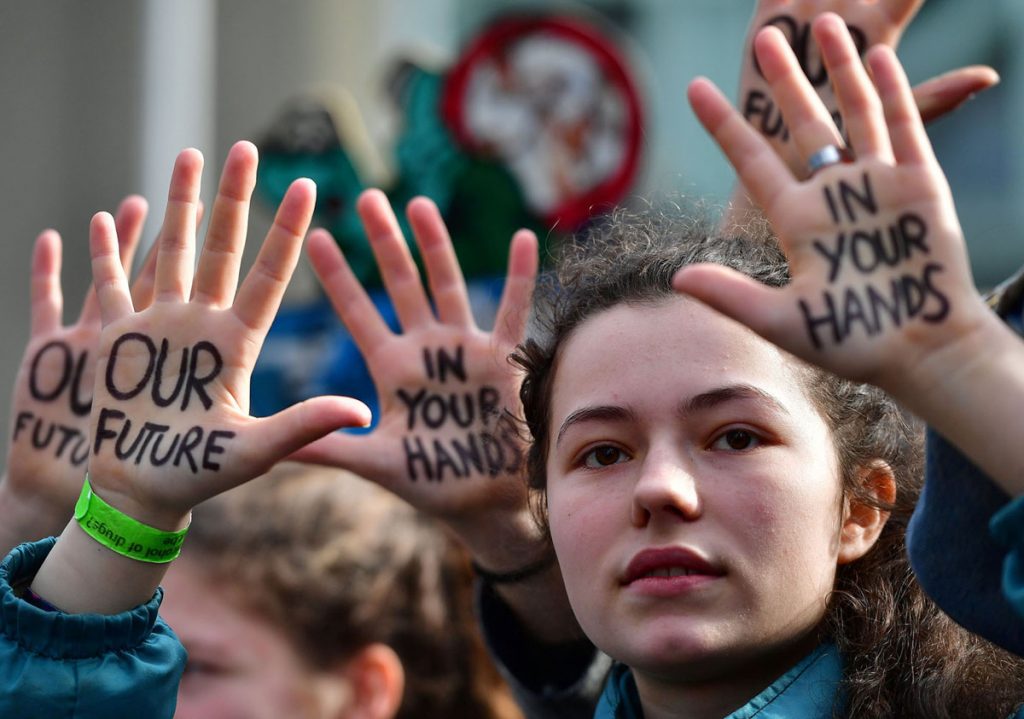
Students take part in a march for the environment and the climate in Brussels, Belgium, on February 21, 2019. Environmental protests and strikes, most led by students, took place around the world multiple times throughout the year. #
Emmanuel Dunand / AFP / Getty
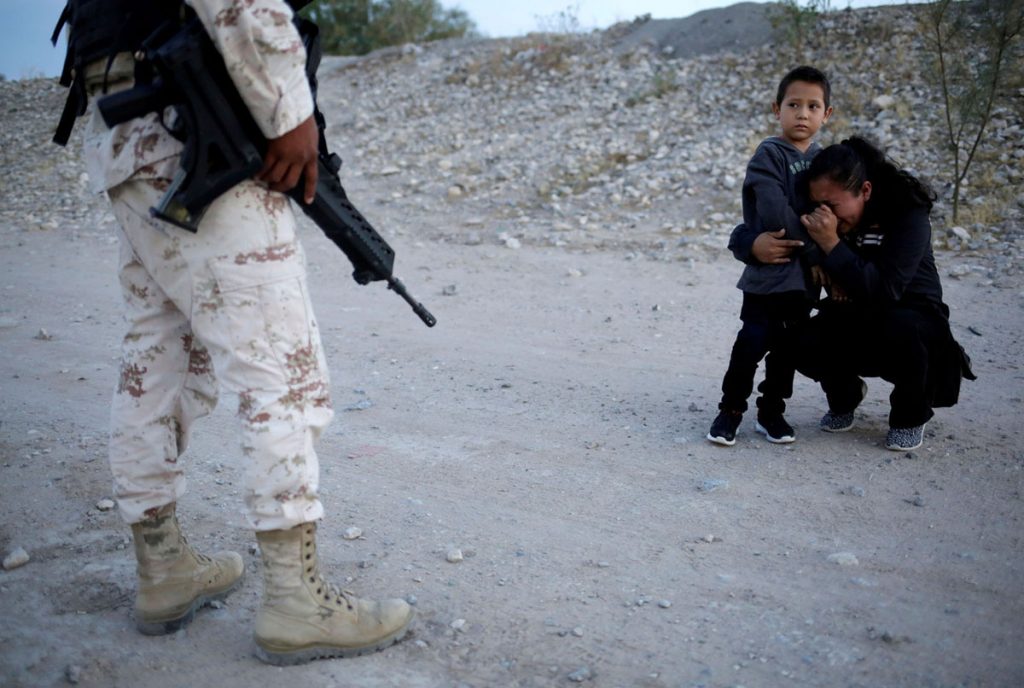
Lety Perez, a Guatemalan migrant, embraces her son Anthony while praying to ask a member of the Mexican National Guard to let them cross into the United States, as seen from Ciudad Juarez, Mexico, on July 22, 2019. Perez and her 6-year-old son had traveled some 1,500 miles from their home country, only to be stopped mere feet from the United States. #
Jose Luis Gonzalez / Reuters

A long-exposure photograph shows a tree burning during the Kincade fire off Highway 128, east of Healdsburg, California, on October 29, 2019. This year’s fire season in California, which lasts through December, has seen more than 6,400 reported fires, including the largest, the Kincade fire, which burned more than 77,000 acres alone. #
Philip Pacheco / AFP / Getty

The United States forward Megan Rapinoe celebrates scoring her team’s first goal during the Women’s World Cup France 2019 quarter-final soccer match between France and the United States, on June 28, 2019, at the Parc des Princes stadium in Paris. The U.S. advanced to the final and won the championship on July 7 in a match against the Netherlands. #
Franck Fife / AFP / Getty
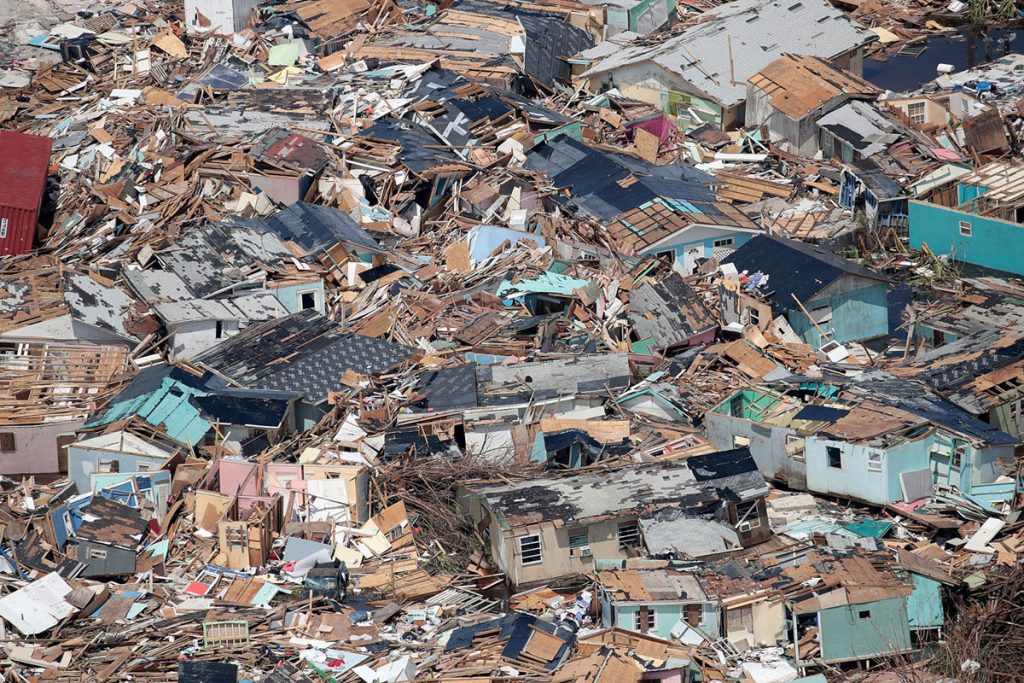
An aerial view of damage caused by Hurricane Dorian is seen in Marsh Harbour on Great Abaco Island on September 4, 2019, in Great Abaco, Bahamas. Dorian struck the islands as a Category 5 storm, and was responsible for at least 60 deaths and more than $3 billion in damages—the worst natural disaster to ever hit the Bahamas. #
Scott Olson / Getty

A young Rohingya refugee is seen during a rainstorm at the Nayapara refugee camp in Cox’s Bazar, Bangladesh, on August 21, 2019. Rohingya refugees said on August 21 that they did not want to return to Myanmar (also called Burma) without their rights and citizenship, with repatriation set to start on August 22. August 25 marked the second anniversary of the Rohingya crisis in Bangladesh after Myanmar’s military crackdown on the ethnic Muslim minority forced more than 700,000 to flee to Bangladesh from violence and torture. The United Nations has stated that it was a textbook example of ethnic cleansing. #
Allison Joyce / Getty
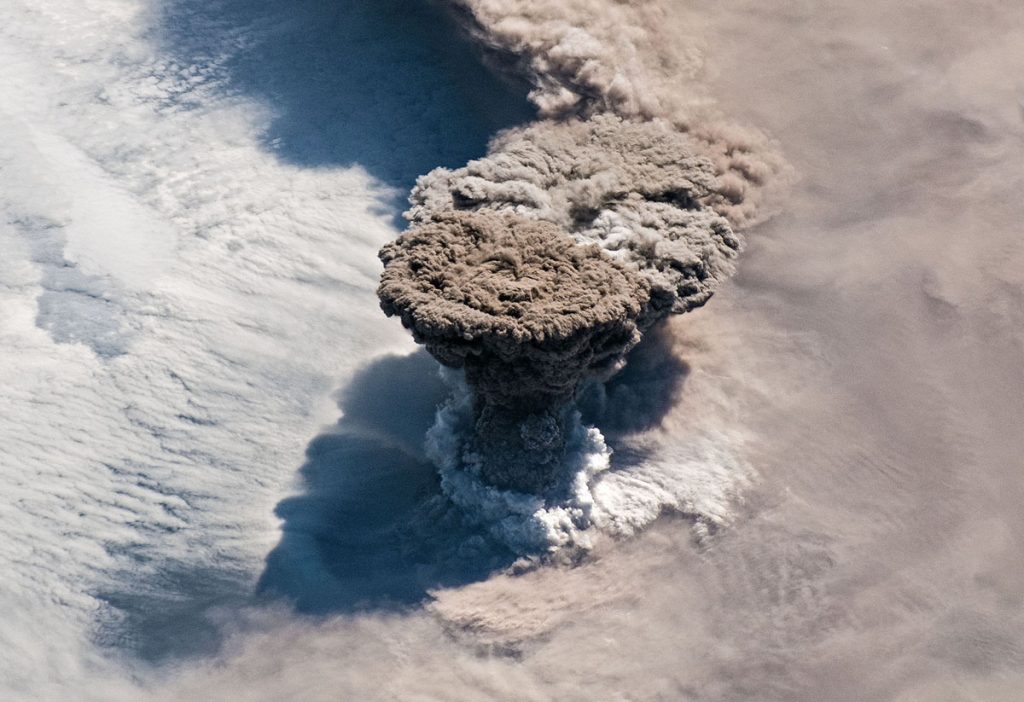
A huge plume of ash rises from Raikoke volcano in the Kuril Islands, as viewed from the International Space Station on June 22, 2019. The small, oval-shaped island most recently exploded in 1924, and before that in 1778. Astronauts shot this photograph of the eruption as the column of ash spread out in a part of the plume known as the umbrella region—the area where the density of the plume and the surrounding air equalize and the plume stops rising. The ring of clouds at the base of the column appears to be water vapor. #
NASA Earth Observatory
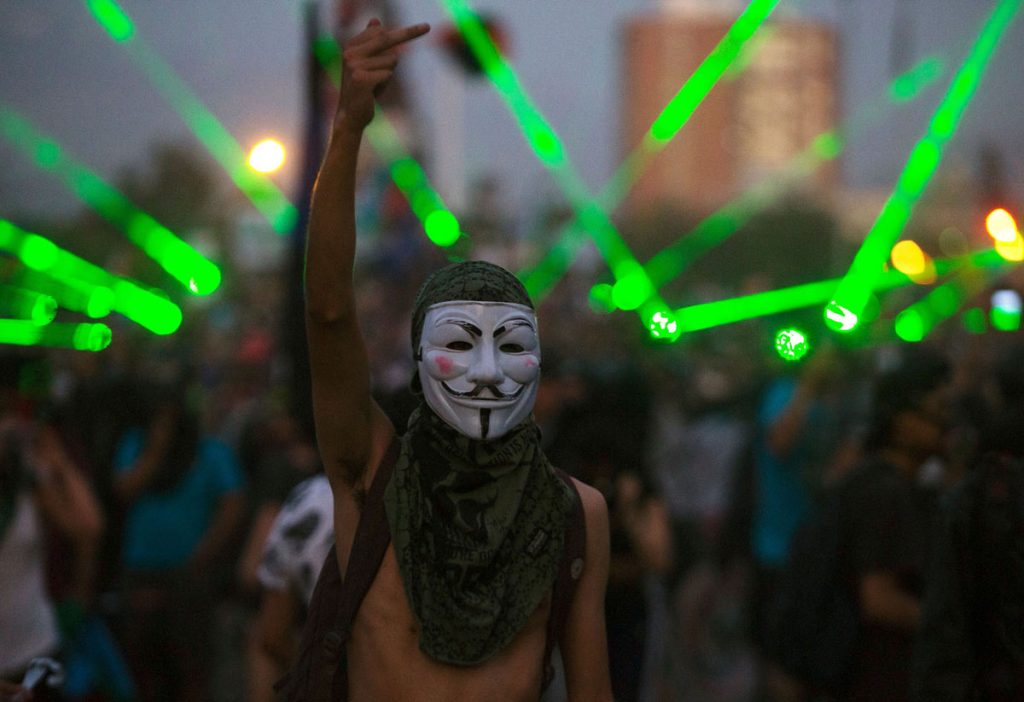
A demonstrator wearing a Guy Fawkes mask gestures in front of others shining green lasers, during a protest against the government in Santiago, Chile, on November 18, 2019. Weeks of violent unrest have rocked Chile, leaving at least 22 people dead and more than 2,000 injured. Chileans are protesting social and economic inequality, and against an entrenched political elite. #
Claudio Reyes / AFP / Getty
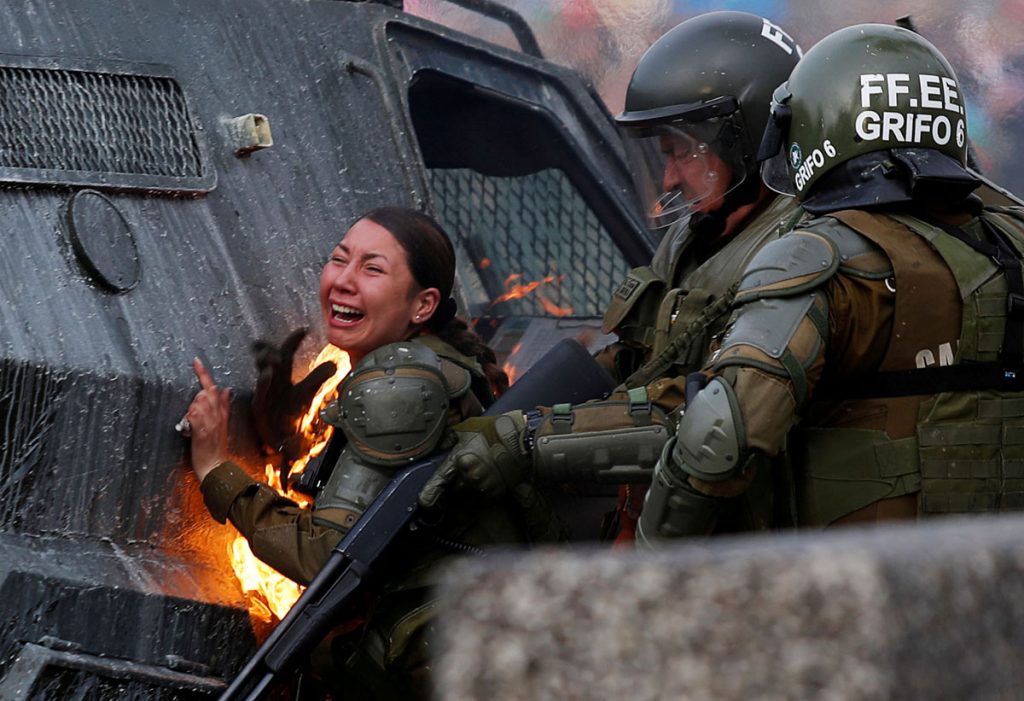
A riot-police officer reacts after a Molotov cocktail landed nearby, splashing fire onto several officers during a protest against Chile’s government in Santiago, Chile, on November 4, 2019. #
Jorge Silva / Reuters
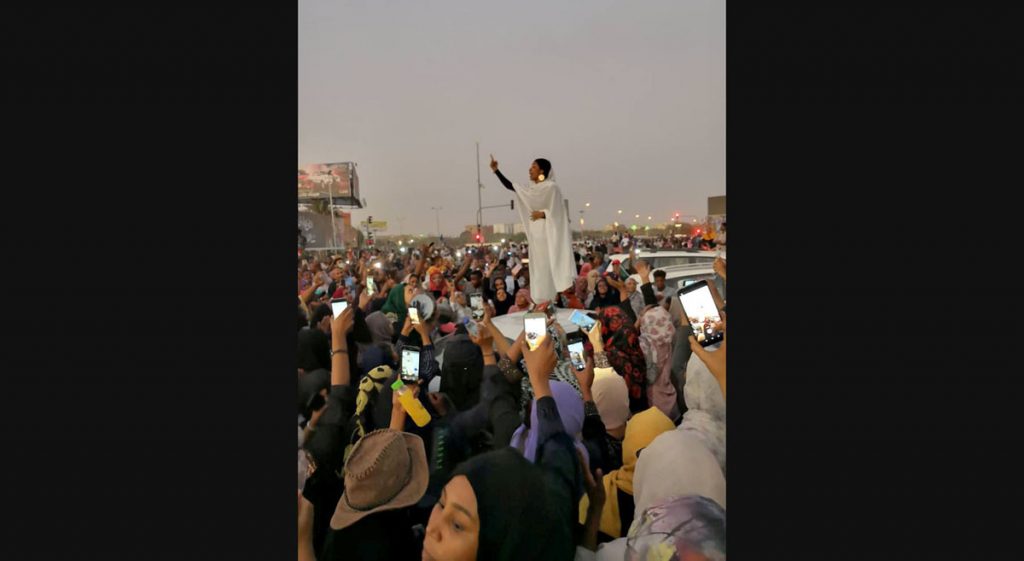
Alaa Salah, 22, stands on a car leading chants during a protest demanding that Sudanese President Omar al-Bashir step down, in Khartoum, Sudan, on April 8, 2019, in this still image taken from a social-media video obtained on April 9. Months of demonstrations and civil disobedience led up to the Sudanese Armed Forces staging a coup on April 11, removing the dictator Bashir from power after 30 years. #
Lana H. Haroun / Social Media
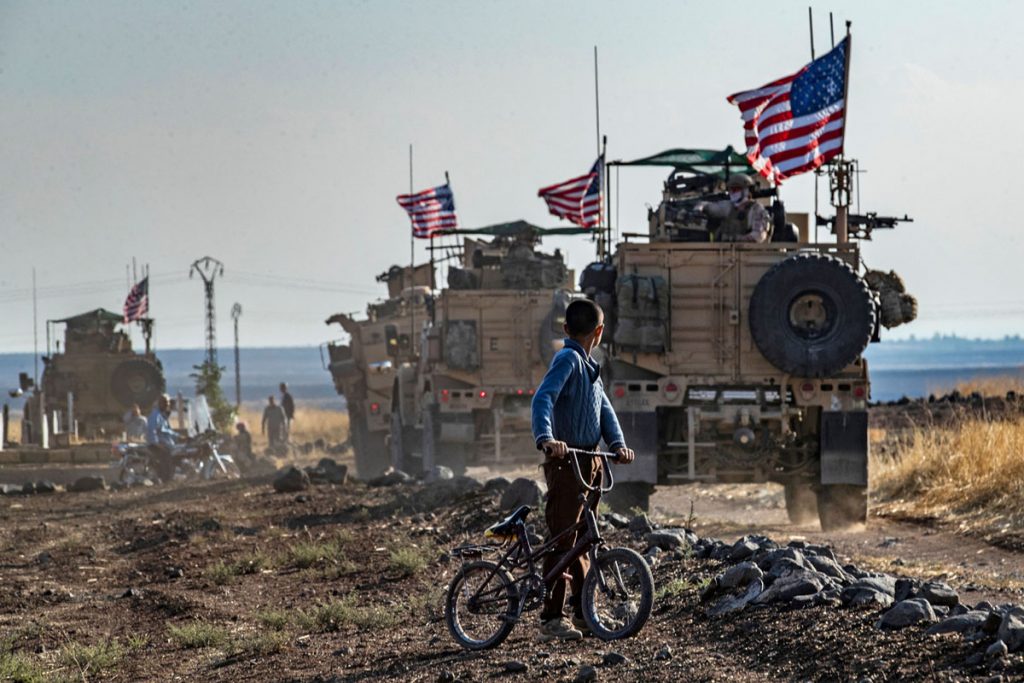
A Syrian boy on his bicycle looks at a convoy of U.S. armored vehicles patrolling fields near the northeastern town of Qahtaniyah at the border with Turkey, on October 31, 2019. U.S. forces accompanied by Kurdish fighters of the Syrian Democratic Forces (SDF) patrolled part of Syria’s border with Turkey, in the first such move since Washington withdrew troops from the area earlier in October, an AFP correspondent reported. #
Delil Souleiman / AFP / Getty

Democratic Chairman of the House Intelligence Committee Adam Schiff awaits Bill Taylor, charge d’affaires at the U.S. embassy in Ukraine, and George Kent, the deputy assistant secretary of state for Europe and Eurasia, to testify during a hearing on the impeachment inquiry into President Donald Trump, on Capitol Hill, November 13, 2019. #
Jim Lo Scalzo / Pool via Reuters

An Iraqi demonstrator takes part in ongoing anti-government protests in Baghdad on November 1, 2019. Beginning in October, frustrated Iraqis took to the streets to voice their anger at years of government corruption, high rates of unemployment, poor services, and economic stagnation. The response from Iraqi authorities was particularly violent, resulting in more than 400 deaths. The demonstrations continue, despite the announced resignation of Prime Minister Adil Abdul-Mahdi. #
Ahmed Jadallah / Reuters
We want to hear what you think about this article. Submit a letter to the editor or write to letters@theatlantic.com.
For more information please visit the following link:
https://www.theatlantic.com/photo/2019/12/top-25-news-photos-2019/602848
Elaborate Chiaroscuro Tattoos by Makkala Rose Burst With Ripe Fruit and Blossoming Flowers
November 15, 2019 Laura Staugaitis
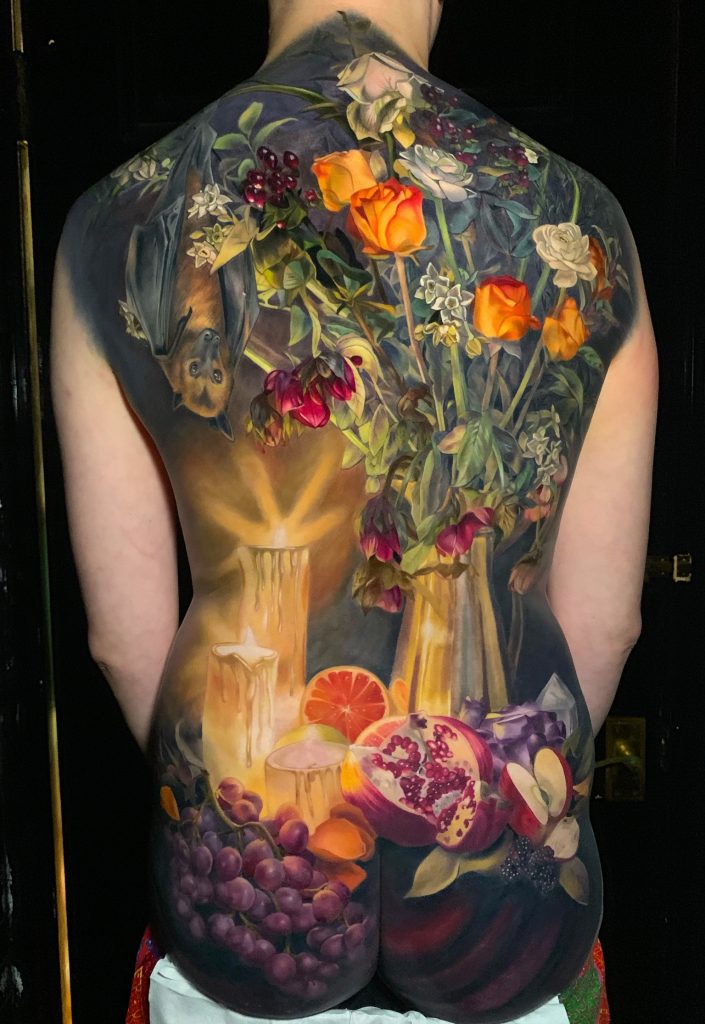
Tattoo artist Makkala Rose creates dramatic botanical designs on her clients’ skin, incorporating richly toned flower blossoms, unctuous fruits, and life-like animal portraits. One recent commission involved completely covering a client’s back with a chiaroscuro “painting” featuring three burning candles, reflective glass and crystals, piles of ripe fruit, and a hanging bat on an inky black background.
Rose’s first love was painting, the artist tells Colossal. “One of my first memories was smearing bright purple paint from the pot onto a fresh sheet of paper stuck to an easel, and my love and fascination with art and creating has never ended.” Now that Rose spends most of her time tattooing, her background as a painter has come into dialogue with her ink work. “The feel and the mood brought through by my color palette and my style of tattooing is influenced by the way I like to paint and now vice versa as I spend a lot more time tattooing, they lend interestingly to each other,” says Rose.

The artist also has a strong personal connection to flowers and gardens (Rose tells Colossal that floristry would be her backup career), and she seeks to imbue her tattoo work with the joy that blossoms bring her. She spends time perusing different bouquet designs, photographing flowers in public gardens, and researching new plants and flowers to expand her repertoire, though peonies and blackberries are perennial favorites.
To create her most recent backpiece, shown above, Rose explains that she personally collected all the materials for the composition, from individual flowers to pitchers and crystals. She then arranged everything in a composition (minus the bat) and worked with a friend to take documentation photos in preparation for the tattoo design.
Rose hails from New Zealand, and travels frequently for her tattoo work, most often across the U.S., U.K., and New Zealand. See more of her designs on Instagram. Rose is usually booked several months out, but you can find out where she’ll be next on her website. If you enjoy Rose’s designs, also check out Esther Garcia’s inkwork.
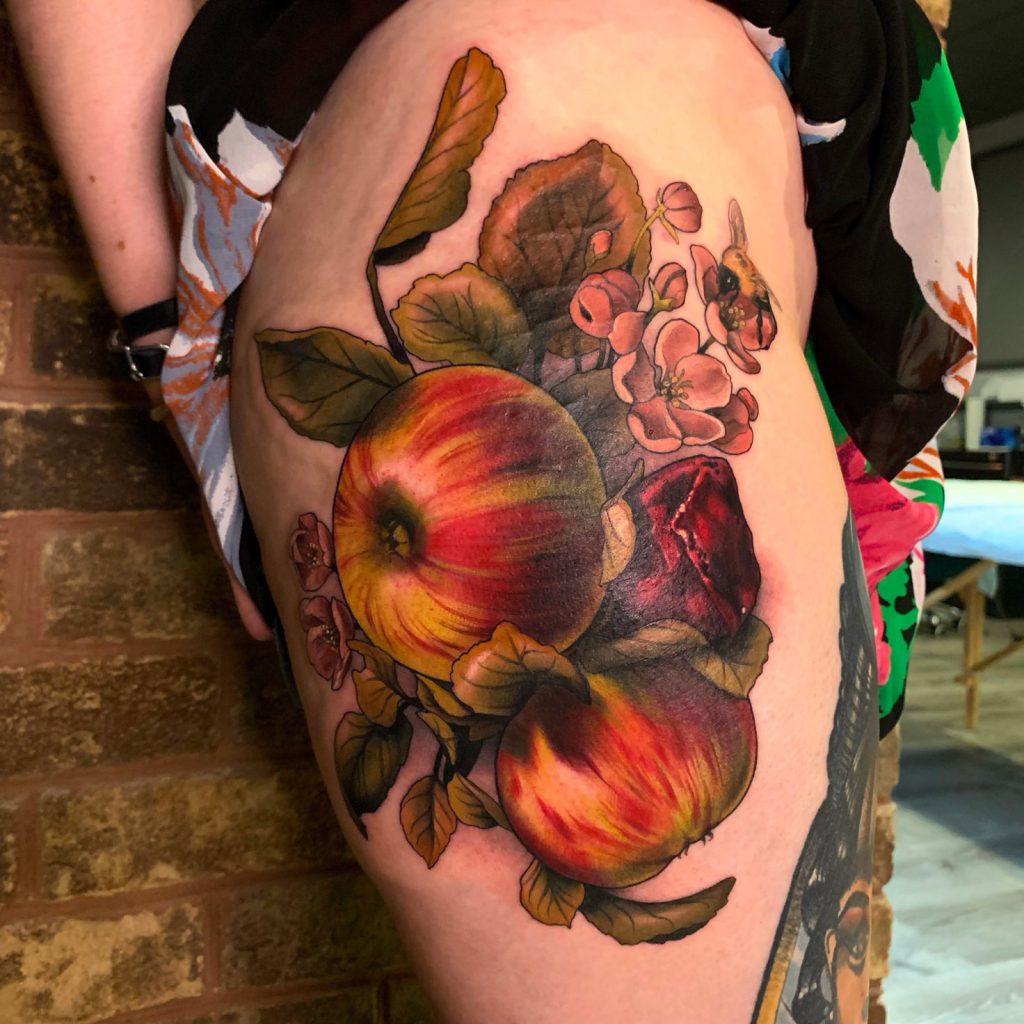





Finished “Peace” artwork 15
Organize by Linda Leonard-Nevels (School Library Media Specialist), Malcolm X Shabazz High School, and Ms. Bongiovanni (English IV, 2014-2015) Newark, New Jersey, December 2014
Finished artwork, after the written comments by Ing-On Vibulbhan-Watts on Friday, January 30, 2015
Link to Finished artwork of Malcolm X Shabazz High School’s Students’ comments, poster 2, on “What does Peace mean to you?” page:
Leave a Reply